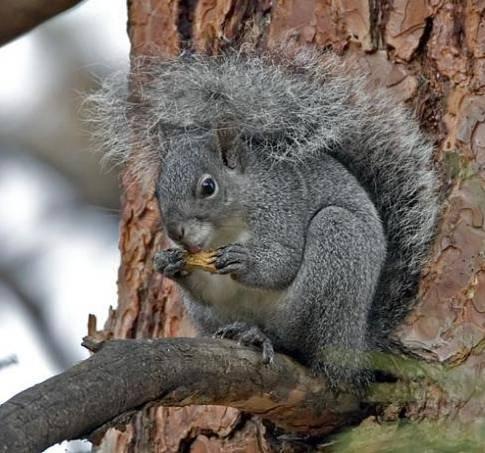By Jacqui Banaszynski
Let's, for a moment, consider squirrels. Stick with me. There's a reason for this, and it has to do with things threatened and endangered.
More specifically to that point, the subject is the western gray. I'm not sure if the subspecies name should be capitalized. It shows up spelled various ways on internet searches, and not at all in the AP Stylebook. To my delight, a live version shows up in front of my mountain cabin. At least, I hope that's what visits me these late winter mornings as my attention drifts between the keyboard and the iced-over world out the window.
For my first three summers here, I was visited by a squirrel I named Moose. He was smaller than the city squirrels I've known, darker and far shyer. Back in my beloved Minnesota, squirrels are often taken for granted, and cute outshouts rodent. (A fluffy tail buys a lot of forgiveness.) But insouciance becomes aggression in some. Cross one on the running path and you best get out of the way. Watch for holes in the soffits lest one gets in the attic and then the house. In recent years, I've seen more and more roaming the neighborhoods of Seattle, preening along the utility cables, staring down traffic and, grrrrr, eating the tender hosta shoots in my garden beds. A dear friend puts food out for them. I do not. In Florida and Texas, populations have swollen to the point where roundups and relocations are threatened — I hope not to my urban world.
These city squirrels, I'm learning, are not western grays. Moose may be. I haven't seen him for a few months — small as he was, he got huge last fall — but a wee replica has been visiting. He (she?) skitters along the snow-crusted ground, grabs a pine cone, then scrabbles up a tree where he shreds it, scale by scale, to get to the seeds within. He, too, is dark and shy but doesn't yet seem savvy in the ways of wilderness skittering. The other day he wandered out to the edge of a thin, needle-less branch where he perched for a good 10 minutes before he figured out how to reverse his course to safety. I was tempted to call the 911 dudes who rescue cats from trees — but in the mountains such things are left to their own devices, or to the cougars.
I always wondered if Moose had a family. His outings were solo affairs. But when the wee one showed up on Valentine's Day I indulged in a bit of romantic assumption and named him Mooseteeny.
And what, you rightly ask, does this have to do with journalism?
If the Moose family that scampers in the pines outside my window are western grays, they are, in Washington state, threatened and en route to being listed as endangered. They survive here in only three places; my small patch in the dry mountain valley of the far north Cascades is one of them. I learned that this week in a story in the Methow Valley News, written by environmental reporter Ann McCreary, She retired a couple of years ago, but still shows up to help a newspaper that now survives with one full-time news reporter, an editor/publisher who also reports and four part-time community columnists who do occasional features for the special sections.
This is where I lapse into the clichéd nut graf segue: The Methow Valley News is not alone. It is one of the longstanding independent newspapers that is clinging to survival in a profession that is threatened and en route to being listed as endangered or extinct. The latest news desert map by researcher Penny Abernathy now counts 200 U.S. counties where there is no local newspaper. Half of all counties in the nation — 1,540 — are served by just one newspaper, usually a weekly, and most of those living on the equivalent of pine cones.
The dangers of this to American-style democracy is well documented. Yet, as with squirrels, people often take their news sources for granted until it's too late, or the rodent version of news rises.
I am thrilled to have a western gray race around my yard and leave shredded pine cones, like gifts, on my cabin porch. I am thrilled to see a fiesty local newspaper in the rack at the grocery store in the mountains and another on my porch in Seattle. I don't, for a minute, take their survival for granted, and know my world will be diminished if they disappear.
***
A version of this post was first published as a Nieman Storyboard newsletter Feb. 17, 2023.
Let's, for a moment, consider squirrels. Stick with me. There's a reason for this, and it has to do with things threatened and endangered.
More specifically to that point, the subject is the western gray. I'm not sure if the subspecies name should be capitalized. It shows up spelled various ways on internet searches, and not at all in the AP Stylebook. To my delight, a live version shows up in front of my mountain cabin. At least, I hope that's what visits me these late winter mornings as my attention drifts between the keyboard and the iced-over world out the window.
For my first three summers here, I was visited by a squirrel I named Moose. He was smaller than the city squirrels I've known, darker and far shyer. Back in my beloved Minnesota, squirrels are often taken for granted, and cute outshouts rodent. (A fluffy tail buys a lot of forgiveness.) But insouciance becomes aggression in some. Cross one on the running path and you best get out of the way. Watch for holes in the soffits lest one gets in the attic and then the house. In recent years, I've seen more and more roaming the neighborhoods of Seattle, preening along the utility cables, staring down traffic and, grrrrr, eating the tender hosta shoots in my garden beds. A dear friend puts food out for them. I do not. In Florida and Texas, populations have swollen to the point where roundups and relocations are threatened — I hope not to my urban world.
These city squirrels, I'm learning, are not western grays. Moose may be. I haven't seen him for a few months — small as he was, he got huge last fall — but a wee replica has been visiting. He (she?) skitters along the snow-crusted ground, grabs a pine cone, then scrabbles up a tree where he shreds it, scale by scale, to get to the seeds within. He, too, is dark and shy but doesn't yet seem savvy in the ways of wilderness skittering. The other day he wandered out to the edge of a thin, needle-less branch where he perched for a good 10 minutes before he figured out how to reverse his course to safety. I was tempted to call the 911 dudes who rescue cats from trees — but in the mountains such things are left to their own devices, or to the cougars.
I always wondered if Moose had a family. His outings were solo affairs. But when the wee one showed up on Valentine's Day I indulged in a bit of romantic assumption and named him Mooseteeny.
And what, you rightly ask, does this have to do with journalism?
If the Moose family that scampers in the pines outside my window are western grays, they are, in Washington state, threatened and en route to being listed as endangered. They survive here in only three places; my small patch in the dry mountain valley of the far north Cascades is one of them. I learned that this week in a story in the Methow Valley News, written by environmental reporter Ann McCreary, She retired a couple of years ago, but still shows up to help a newspaper that now survives with one full-time news reporter, an editor/publisher who also reports and four part-time community columnists who do occasional features for the special sections.
This is where I lapse into the clichéd nut graf segue: The Methow Valley News is not alone. It is one of the longstanding independent newspapers that is clinging to survival in a profession that is threatened and en route to being listed as endangered or extinct. The latest news desert map by researcher Penny Abernathy now counts 200 U.S. counties where there is no local newspaper. Half of all counties in the nation — 1,540 — are served by just one newspaper, usually a weekly, and most of those living on the equivalent of pine cones.
The dangers of this to American-style democracy is well documented. Yet, as with squirrels, people often take their news sources for granted until it's too late, or the rodent version of news rises.
I am thrilled to have a western gray race around my yard and leave shredded pine cones, like gifts, on my cabin porch. I am thrilled to see a fiesty local newspaper in the rack at the grocery store in the mountains and another on my porch in Seattle. I don't, for a minute, take their survival for granted, and know my world will be diminished if they disappear.
***
A version of this post was first published as a Nieman Storyboard newsletter Feb. 17, 2023.



